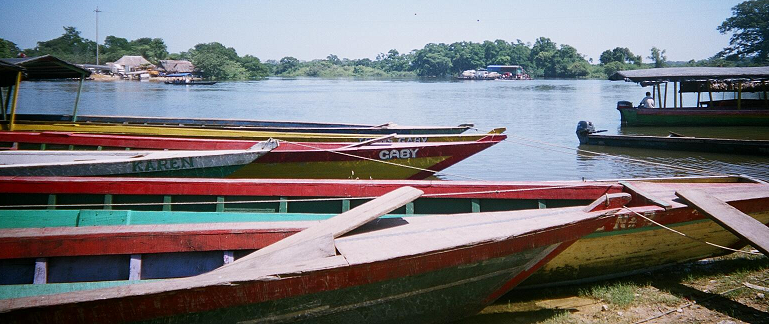
Go south, from Arizona or Texas. You are in Mexico. Keep going, a thousand miles. Welcome to Guatemala.
The Petén, Northern Guatemala. It makes up the southern most part of the Mexican Yucatan Peninsula. I am sitting in a motorized canoe, a lancha, which will take me back to Mexico. I am nearing the end of my two week excursion. My trip has been a giant circle through the land of the Maya, the indigenous inhabitants of old who still make up the majority of the population. Starting in Chiapas, the southern most state of Mexico, I have journeyed through the bottom of Guatemala to the top. I will return through Tabasco, the other Mexican state bordering Guatemala.
What am I doing here? A clue. I am quite possibly the only turista in Northern Guatemala who didn’t come to visit the pyramids. I have not boarded the tour buses full of people from Mexico, Minnesota or the Netherlands. I am not on my way north to sip Margaritas on the beaches of Cancun. I try not to dress like a back-packer from Croatia or Israel.
In this little town called El Naranjo, the beautiful San Pedro River dominates the view. On all sides of me, are forests and grazing land for cattle. Thirty years ago, the Petén, as well as much of the Yucatan, was jungle. But much of the largest jungle in the hemisphere has been cut down. Hidden in what remains of the jungle are hundreds of Mayan pyramids, some rivaling those of Egypt. Enough wilderness still exists to make the Petén a prime staging area for everything traveling north: poor youth from Honduras; slaves who were kidnapped in Eastern Europe and China; drugs from Columbia; jaguars and monkeys, illegally caught in Guatemala’s protected biosphere reserve. El Naranjo is the starting point for the remote, northern jungle route. It is the best place for migrants to avoid detection. And it is the best place for smugglers and drug traffickers to move their supply, from their hidden poppy and marijuana fields and air strips.
But what am I doing here?
Ok. I came to gain a better understanding of the experience of a few Chicago friends who emigrated from these lands the hard way – with no documents. Theirs is the experience of thousands of Latino migrants living in Chicago. They are separated from their families. They work twelve to fifteen hours a day, seven days a week. They bus our dishes, mow our grass, paint our apartments. They come from Mexico, Guatemala, Honduras, El Salvador, Columbia. They don’t talk about how they got here. They live in fear of being sent back. They don’t talk about the harassment they receive. They are lucky. They made it here. Even with their low wages, often withheld by their employers, they make more than they ever could have in their home countries. Most send over half their income to back to their families. At home, their children might have been starving. Now, maybe they can go to school.
Sorry. I get a little passionate.
I wait for the boat to launch. It is hot, despite the early morning hour. Lancheros, the drivers of the sleek, motorized canoes with canopies, barter for price, trying to usher the van loads of migrants to their boats. Giant sacks of unknown contents are unloaded from the vans, and loaded into some boats.
I daydream. I am back at the starting point for my trip. The postcard perfect city of San Cristóbal is the tourist capital of Chiapas as well as the retirement village for all reincarnated Volkswagen Beetles. The paradox of Mayan existence is typified in San Cristóbal. In 1994, the sleepy village was occupied by the previously unknown Zapatista revolutionaries. While the horseback riding, pipe smoking, ski mask wearing Subcomandante Marcos attracted more international media attention than the Joan Benet Ramsey affair, the continuing presence of the Zapatista movement betrays unmet needs of a poor, indigenous population. The Maya of today have reacted much like they did in the original conquest by a powerful, foreign culture from Europe – with similar results. I remember the communities that allowed me to visit. They were not unlike so many other Maya villages which I had previously visited in Guatemala. (Why should I be surprised? After all, there was no Mexico or Guatemala for centuries of Maya existence.) The women’s native dress is a rainbow of bright colors and intricate weaving — the stuff of Mexico and Guatemala travel agency posters. But like tropical birds in a cage, or cut flowers in a vase, the population continues to experience the same misery of previous generations, despite the talk of the politicians.
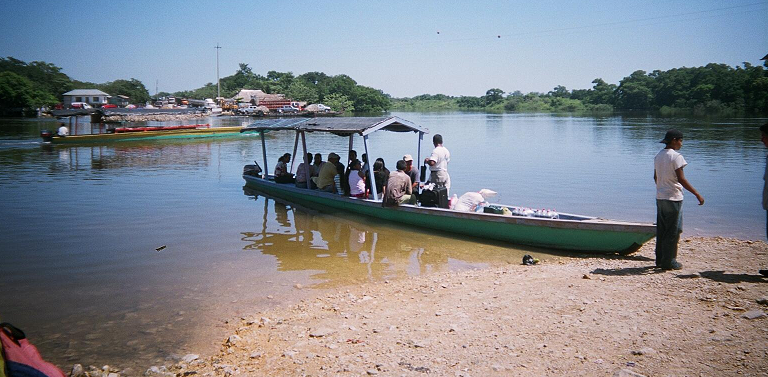
Did I say it was hot? I have emptied my half-liter bottle of water. It is not even noon. Groups of people gathering for their river trip through this northern crossing point into Mexico. I think of my Chicago friends. Maybe they didn’t cross here. Maybe they crossed into Mexico further south. Like many migrants, maybe they were caught in Mexico and deported back to Guatemala. My mind drifts to my time in Comitán, Mexico, a collection point for detained ilegales. I think of my interview with the head of Immigration for the northern part of the state of Chiapas. I replay conversations with Immigration agents — la Migra, as they are called. Their stories fill my mind. I picture the holding facilities for rounded-up ilegales. I see orange uniformed representatives of Grupo Beta, a watch-organization of the Mexican government, as they check on the welfare of the detainees. I see the disappointment on the faces of another group of detainees, brought in while I am there. More Guatemalans — everyone claims to be Guatemalan, so as not to be sent hundreds of miles back to their own countries, further south. I feel the frustration of the man and his wife, who can’t hold back tears. I see the teenagers from Comitán who show up with a food basket for a woman they met before she was detained.
Maybe my Chicago friends crossed near the Pacific coast. Tecun Umán is the main crossing point into Mexico, for most Central and South Americans going north. Maybe they rested at Casa del Migrante, a shelter run by Catholic missionaries. Migrants, on their way to El Norte, sleep for a day or two in the shelter, a zone of safety. The stories run through my mind. Most have been on the road for one or two weeks, traveling through Honduras and Guatemala. They haven’t slept for days. Tecun Umán is controlled by organized crime and by viscous gangs like Mara 18 and Mara Salvatrucha, recognized by the tattoos all over their bodies. Fueled by deportations from the United States (most U.S. deportees are gang members), gangs are out of control in the major cities of Central America. Walking through Tecun Umán, about a quarter of the migrants don’t make it through the town and across the river without getting mugged, if only for their few dollars or their worn tennis shoes.
I retrace my hike across the three-quarter mile long bridge from Ciudad Hidalgo, Mexico, to Tecun Umán. I recall the erosion in the river bed from Hurricane Stan, which washed out bridges and caused massive landslides across northern Guatemala. I picture the ever-present inner-tube rafts, carrying people across the Suchiate River; hundreds of families each day; men, women and children with no passports, dressed in their Sunday best, all with hopes dreams of life in the Promised Land. Some make it across to Mexico with their two-thousand dollars, their life savings, which they need to hire a coyote to get them into the U.S. Many have already paid, crossing in groups, with the coyotes. Many are on their third or fourth attempt to rejoin their group in Mexico, after having been caught and sent back to Guatemala.
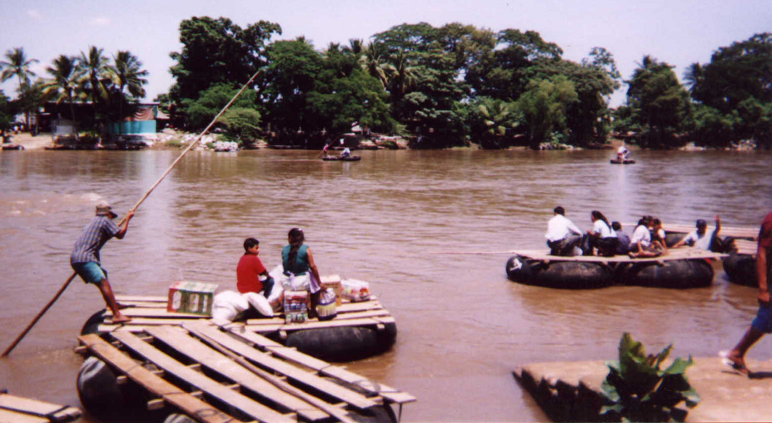
In Mexico, all of them will play a game of Russian Roulette, trying not to get sent back by la Migra, or trying not to lose their savings to corrupt police or gangs — they are everywhere. Poor migrants, over half of them children, travel the freight train called “the Beast.” Clinging to the tops, or in between cars, hundreds jump on and off the moving train at stops, to avoid la Migra. Many lose their arms and legs to the wheels. Many die. The rest hide not only from la Migra, but from the gangs, who also ride the trains and infest major stops, robbing, beating victims or throwing them from moving trains. The travelers pray for strength to survive the cold nights, fighting-off sleep so that they don’t lose their grip and fall from ladders between the freight cars. The winners, in a few weeks, join the throng that reaches the Mexican towns bordering the U.S.
By the time they reach the U.S. border, one in five migrants have already been caught and sent back to their countries of origin. Mexico deports hundreds per day, delivering them in buses to respective Immigration facilities the border towns of Guatemala, Honduras, Costa Rica, etc. Add to that, the plane loads of those deported from the U.S. Over half will start the trip again. Many migrants make the journey five to ten times before successfully getting to the U.S. Others never make it.
Crossing into the U.S. is not a solo experience. Almost all have paid to join coyote operated networks to guide them across the river and desert, and into safe houses on the U.S. side. The travelers pray that their polleros, the guides paid by the coyotes, won’t rob them or abandon them in the desert or let them suffocate under a truck load of oranges. Groups of migrants, as well as their polleros, get lost and die in the intense heat.
What made my Chicago friends risk their lives to travel north? Didn’t they know the dangers? What made them try it again – over and over — even after great loss?
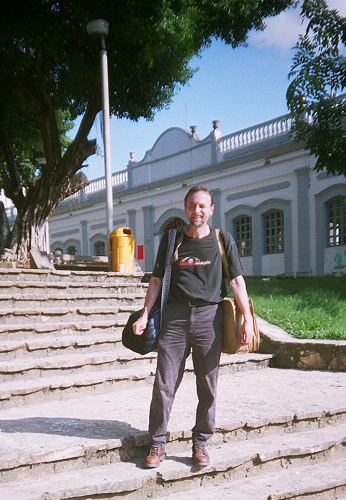
I am getting thirsty. More people are getting in the boats that line the shore. I wonder how many have made the dangerous voyage to the U.S. before. I realize these groups of travelers have already faced a number of trials before they got to this peaceful Guatemalan river. I shut my eyes. Again, I am on a bus full of peasant campesinos and migrants, picking their way through Guatemala. It is four-thirty in the morning. We stop at many check-points. Some are staffed by Guatemalan Immigration officials (looking for ilegales); some, by local police (looking for bribes from bus drivers); and others, by the Guatemalan army (looking for drug and contraband trafficking). Machine guns are not in short supply in Guatemala. The bus driver is sympathetic to migrants. He picks up groups on the roads, gives lectures and tips to those who try to get wise at check points. He stops in the middle of nowhere, to let groups get off to head for some secret crossing point into Mexico.
Two boats are full. The lancheros move groups of people from boat to boat. I say I am going to La Palma, Mexico, four hours down the river. The lanchero says that I don’t need to go all the way there. I can go to Ceibo, where I can catch a van. I decide to trust him. I sit next to woman and two children, smiling, scared; their entire contents in a small duffle bag. Passengers are rearranged. I am switched between boats, three times. A stereotypic, sleazy looking gentleman — gold chains, expensive watch — seems to run the whole show. He treats the passengers with disrespect, constantly cutting them (and me) down in small-talk with his buddies.
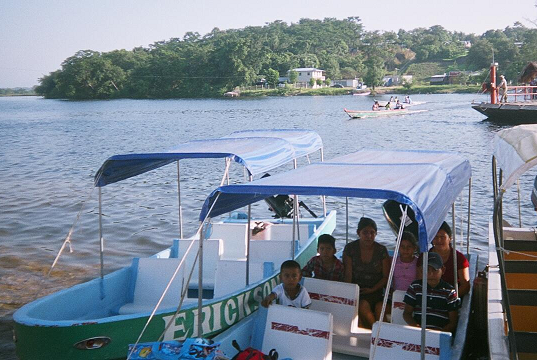
By the time we leave, the boat is filled with a group of men. Traveling down the river, I learn that they are Hondurans, all traveling in a group. The boat takes us to the Guatemalan Immigration check point, looking like no more than an out-house. The Hondurans have the common ID’s that allow them into all Central American countries (except Mexico, I learn later). The Immigration officials joke with them, and with me. I am the only one with a passport. The official turns on his computer – he must process me, differently. He asks if I am a mojado, a wet-back. I tell them that I went the wrong direction; that maybe I should be called a secado — I mean “dry-back,” but it probably translates more like a recovering alcoholic. They all laugh.
The Customs shack, next door, is nothing more than poles and a corrugated-steel roof. Behind the open-air tables, wait four soldiers in full camouflage fatigues, helmets, holding machine guns. They check through the baggage of the Hondurans. They look at my passport and politely wave me on.
Back in the boat, the Hondurans are happy and excited, pointing out scenery along the way, joking with each other. I want to tell them of the dangers they are about to face in Mexico. I hold back, thinking that they may know better than I. I wonder if they have a coyote or pollero with them, already. They dress and act like the others, in case the group is detained. Groups are usually under threat, not to give away the guides’ identities. Immigration agents in all countries agree on one thing. They hate coyotes, whom they see as promoting illegal immigration and making lots of money by endangering lives.
After an hour, we pull into a small clearing on the side of the river. A few other boats are there. We are met by a couple of people with pickup trucks. The Hondurans climb into the back. They usher me up front. We slowly pick our way through the giant rocks of a dried stream bed. It takes a half hour to go a half mile. We are now in the town of Ceibo, Mexico. We pass the couple of shacks that make up the center of town. Next, a narrow half-mile long path, just wide enough for the pickup, bordered on each side by rows of pole booths with colored cloth roofs – a market, as large the ones in the small towns I have previously traveled through, with indigenous locals selling their wares – to whom? I wonder. I look back. The Hondurans are gone. It is just the driver and I, in the pickup.
The market stalls end. A green sign, the kind that sits on any expressway, hangs over the little road – “Welcome to Mexico.” Making it through the small border station without even having to pay a bribe, I survey the dirt road ahead of me. It goes on forever. I walk in the intense degree heat, carrying my duffle bags on each shoulder. I see a parked school bus, painted white. The driver takes me a couple of hundred yards up the road and stops. He says he won’t go out for another hour. I join him under a little shack; the only shade. More stories of the myriad of ways the migrants avoid the Immigration post. It usually takes them a day or two, traveling through the woods. I think of my boating pals.
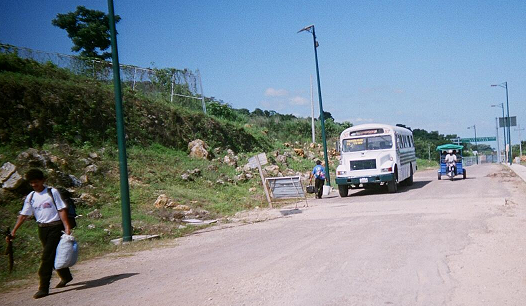
After a couple of hours, I am told that the bus will not go out today. They say I should catch a colectivo. I have traveled most my trip in these twelve-passenger vans (in which they often cram about twenty-five people). I wait. The one I finally board is already occupied by a small group of men and women. I begin to notice that each of them, women and men, have marks around their eyes, like they have been hit. One man’s eye is swollen shut. I start to imagine what might have happened. The women won’t look up. As they go down the long dirt road, small groups of migrants are walking. The van stops for each group, and crams them in. No choice, I say to myself. Walking in this heat, they wouldn’t last a day. A new record. Thirty-two people in the twelve-passenger van. A nice breeze comes through the windows as we move. But at each stop, our sweat soaks us in a couple of minutes. The oxygen seems to disappear. I taste how easily migrants suffocate, stuffed like sardines in the trunk of a car or under cargo in a truck.
We pass through another check point, with soldiers in helmets and uniforms, carrying machine guns. They make everyone get out, and check through luggage. I watch two soldiers struggle with my Hefty trash can liners — great for protecting against rain-soaked luggage on the tops of busses. Nobody is detained.
My trip is almost over. After traveling through more Zapatista villages, and passing huge army bases, I decide to play the tourist for one day. Ocosingo, the town where the only fighting took place after the Zapatista rebellion in 1994, is also the home of the Maya ruins of Toniná. All the other tourists have stayed at the Palenque ruins, further north. I have Toniná it all to myself. And it is huge, built into the side of a mountain – stairs that reach the heavens. Hard to imagine that I will be on a plane, and back to work, in three days.
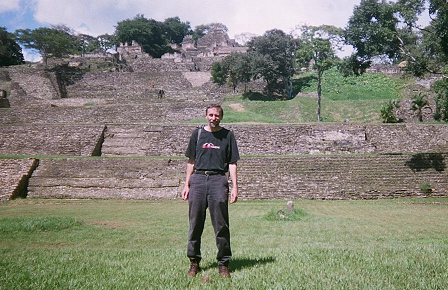
Sitting at the airport in Tuxtla-Gutierrez, I see my final slice of the migrant experience. A pretty woman, elegantly dressed, sits next to me at the gate. We have been sitting there all afternoon. An Immigration official appears, dressed in classic navy blue, and asks for her documents. After a conversation, lasting more than an hour, she is led away, crying. How frustrating it must have been for her. So close. She has already paid her ticket.
I am back in Chicago. The bananas at my local produce store lack a certain vibrancy. I guess their long trip northward has taken its toll. I watch the smiling young man unload crates of vegetables. He jokes, in Spanish, with his buddies. Most ignore him. But some would call him a criminal. Even if he came here, legally, he is taking a job from someone else. Some don’t see him as “deserving” a better life, at the expense of those who say, “We were here first.” Sure, maybe he came for nothing more than to make it big in the U.S. Maybe he wasn’t starving. Maybe he is one of the lucky few who are legally allowed to obtain residence in the United States. But my guess is that it cost him, dearly, to come.
The community is to have the same rules for you and for the alien living among you; this is a lasting ordinance for the generations to come. You and the alien shall be the same before the LORD…
-Numbers 15:15 (NIV)
Copyright © 2006 David Lindstrom. All rights reserved.




